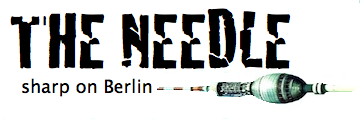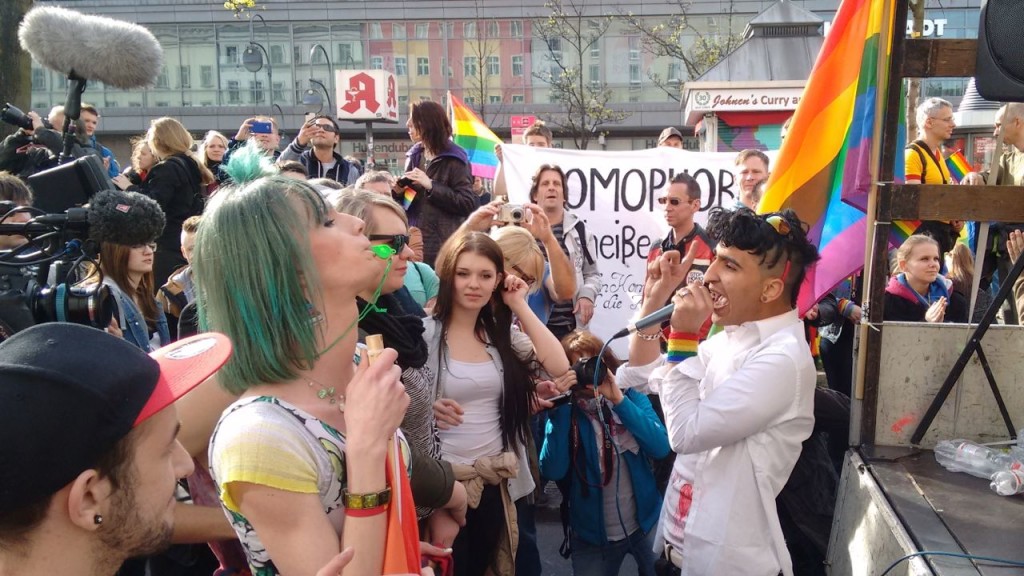WAS IST POST-GENDER? and CAN BERLIN BE POST-GENDER?
by Joseph Pearson
Can Berlin be a post-gender city? And is it willing? What would it mean for spaces in Berlin to be post-gender? I challenge you: how many post-gender spaces can you think of in Berlin?
Let’s start with the term: post-gender. What is it? And I pose the question––”was ist Post-Gender?”––in German, because I wonder whether this discussion easily translates into German, a language run through with strict categories of masculine, feminine and neuter, while in English we conveniently have a single grammatical gender. That this discussion might seem “a little 90s” to English-speakers is a statement of its own, when speaking in a German context. For about thirty years already the difference has been made in English between sex (a biological category) and gender (a social category, that is a way of presenting oneself to and being understood by the world). “Post-Gender”, then, means going beyond performing strictly defined gender roles in public. A post-gendered world can also then be post-sex, in that it calls into question biological categories as well.
Part and parcel of being “post-gender” then is not defining one another by our chromosomes. It is a position that challenges the fundamental control mechanism of our societies: the binary of male and female, privileging the male and patriarchy and distrusting any expression that falls outside that division. It is to reject an order that hates “men who act like women” or fears “women who dress like men”. Post-gender rejects the very notion that one can act “like a man” or “like a woman”. It is a rejection of an order that gets “creeped out” when “that man doesn’t have a dick”, or “that woman doesn’t have breasts”. It is a rejection of misogyny that hates perceived female attributes in men. It is a protest against criminals who beat up someone on their way back from a club in Friedrichshain because (s)he was wearing nail-polish.
But a refusal of this system goes well beyond proscriptions on gendered-clothing choices. Or protests against how we colour-code our children or make gendered choices with regards to their toys. It also goes beyond how we use language, the pronouns we give one another. (In Sweden, for example, already in the 60s, a non-gendered pronoun was adopted; in English “they” increasingly means “he or she”; language, of course, creates worlds, and a revolution in that domain has yet to happen in German, despite the addition of *innen to feminise nouns or the increasing rejection of man as a stand-in for all of humanity).
What “post-gender” requires is an even broader transformation. We need to change the way we look at one another: to train ourselves to see each other differently: not as “that girl” or “that boy” but as that person. This assertion may sound imprecise, but that something fuzzy is at the heart of the challenge should not be an impediment to action. This does not necessarily mean negating certain physical differences between sexes that can be described scientifically, but rather to question the primacy of those differences in cultural practices and in language. Those differences should not be exalted to a powerful and defining role. Being “post-gender” asks one to define identity beyond sex as the fundamental descriptor, to stop defining even if you believe you have a clear (cis-?) gender identity, so as to give others who don’t the space to be free. To think “post-gender” is, fundamentally, a neo-humanist position (and I am fully aware of how the category of humanism has been critiqued).
How space is used in Berlin can help facilitate a transition to neo-humanist thinking. But try to think of places where gender expression is traditionally controlled, and where the space has already been altered/neutered in the city to annul that power. The most obvious example, of course, is the single-sex toilet. But if you visit any public institution in Berlin––a State museum, a theatre, a government office, a school––you will almost certainly find toilets separated by a sign marked “Herren” or “Damen”, or “H” and “D” (with punishing long lines outside the doors marked “D”). Those doors are colour-coded blue or pink, or, for that matter, have icons representing people wearing clothing that reinforce the presupposition that only women wear dresses. This binary, of course, excludes anyone who feels they fall in-between. Berlin remains, alas, a Hauptstadt of traditional gender norms.
The question of non-sex defined toilets has become a question of national debate in the United States––even with the involvement of President Dump––but somehow has not penetrated into the German national consciousness. Why is that? Does one really need to visit a tiny restaurant or bar, that is too small to have separate bathrooms, or a queer bar like Südblock at Kottbusser Tor, to experience a sex-liberated zone? Why are we so far behind in this city? Because of the slow changes in a gendered language, already mentioned? Because of the continued dominating influence of religion in society (its name gracing Germany’s ruling party)? Is it because Germany continues to be a place where the sex-gap in pay is one of the greatest in Europe––and this is indicative or deeper more traditional trends?
I’d like to suggest that everything is possible here if we put our minds to it. And I’ll start with how we’ve moved on, in da Hauptstadt, from another term: ‘gay’, as a comparison for the word ‘gender’. Increasingly many, especially millennial, Berliners do not want to identify as ‘gay’, even though they are primarily attracted to those of the same sex. This is not because they are self-hating and unable to accept their sexuality. Rather, they are perfectly comfortable with their alterity: comfortable enough to recognise it includes ambiguity. And in a German political space where many (but not all) civil rights have been afforded same-sex couples, the emphasis on a limiting term to define a group for political solidarity loses its momentum in the face of more accurate individual self-determination. Often, the term “gay” has a historical resonance; it describes past actions––a history of same-sex desire for the person. But should a historical term predetermine, decide on a rigid future that closes off attractions in other directions? You might not want a definition that limits freedom. What if, some day, you are attracted to someone of the “opposite sex”? Or to someone who is transsexual? What if you want to keep your sexual identity more open to provide comfortable space for others to do the same?
We have a word for a more open, ambiguous, inclusive sexuality: but I don’t like the term “queer” (which is convenient enough that I used it above) because it is an appropriation born out of a history of prejudice. So we float, homeless, unattached semiotically. Could the best word be “post-gay”; in its negation of the past, it opens up a future? Or is “post-gay” too problematic because it reminds one of the promise of conversion clinics, that wish to cure the gay malady?
“Post-gender” does not have that problematic confusion. And if Berlin is already a “post-gay” city––something unimaginable even twenty-years ago––might it not also become “post-gender”? The queer / “post-gay” scene as it has emerged especially in Kreuzberg, Neukölln, and Friedrichshain, includes a mix of sexes, genders and identities; it welcomes experimentation and the non-defined, and it cannot be called a place that reneges on its political obligations. What would it take to make spaces also “post-gender”? We can start by asking establishments why they have sex-divided toilets. We can express it by violating gender norms in our vestimentary choices, by bringing that challenge into public space by playing with expectations. It means being allies to our trans friends in their political battles, and not being complacent in the upcoming election season. It means seeing the person in front of you, rather than a man or a woman, and teaching this to our children and in their schools through gender training and the abolishment of sex-divided toilets and changing rooms.
None of this is meant to conclude a discussion, but rather to invite it, in a city that should be at the forefront of disobedience, one that has a proud history of asking these questions (think of Magnus Hirschfeld and co.). It is a place where a promise can be fulfilled.


Even in science, binary genders do not exist. I challenge those who still belong to the old traditions to look up sex chromosomes: XO, XXY or XYY. Are you willing to lable them?
I also do not like queer as a word. Pansexual is a bit awkward but much more useful.